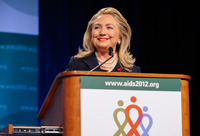[Article taken from Science Editor, originally by Anette Breindl]
In July, the International AIDS Conference occured on U.S. soil for the first time in more than two decades, the theme was “Turning the Tide Together.”
That spirit contrasts sharply with the last meeting to take place in the U.S., which was held in San Francisco in 1990.
“That was at one of the worst periods of this epidemic,” when an AIDS diagnosis was the equivalent of a certain death sentence, Paul Volberding, director of the AIDS Research Institute at the University of California at San Francisco, told reporters at a preview of the conference that was held at UCSF this week. “It’s obviously a completely different world now.”
And it’s only recently that that world has changed so much for the better. Conference co-chair and San Francisco General Hospital chief of the Division of HIV/AIDS, Diane Havlir, pointed to four scientific advances that have moved the notion of ending the AIDS pandemic from preposterous to possible.
Three of those advances, collectively, fall under the rubric of “treatment by prevention.” One was the XX HPTN trial, which showed that treating infected individuals with a cocktail reduced transmission of the virus to their uninfected partners by 96 percent, while keeping the treated individuals healthier as well. Those trial results were named “Breakthrough of the Year” by Science Magazine in 2011. (See BioWorld Today, May 13, 2011, and Dec. 27, 2011.)
Two other successful interventions have been pre-exposure prophylaxis, where high-risk individuals take a combination of two HIV drugs, and in areas where HIV is transmitted mainly through heterosexual intercourse, circumcision reduces men’s risk of becoming infected. (See BioWorld Today, Dec. 23, 2010.)
And the so-called Berlin patient has provided proof of principle that even after an HIV infection has taken root, it is possible to cure a patient, even though such a cure may not be clinically feasible at this point for most patients. (See BioWorld Insight, May 23, 2011.)
Havlir said that together, those scientific advances have “resulted in the ignition of an entirely new research agenda that adds to our other research agenda of an HIV vaccine.”
She cautioned that “a decisive victory is going to take a cure or a vaccine or both.” And she also stressed that in order to seize the opportunities that scientific advances have presented, it will be necessary to figure out how to implement them. A major part of that question, in turn, is who will pay for such implementation.
“We know [prevention by treatment] works in research settings,” Havlir said. “Really, the question is ‘Who is going to pay?’ . . . What will the price tag be and who needs to step up to the plate?”
But all things considered, it is “a remarkable time in AIDS history because for the first time, we are talking about the beginning of the end of the AIDS epidemic.”
Given that unique moment, she added, it is fitting that the International AIDS conference returned to the U.S. this year.
The conference stopped coming to the U.S. after 1990 due to a travel and immigration ban for HIV-positive individuals into the U.S. That ban was lifted in 2009, and so the conference, which happens every two years, has returned to the U.S. in 2012.
Havlir considers that return fitting. Despite its past travel ban, overall, “the United States has exhibited tremendous leadership in the AIDS response,” she said. “And certainly it hasn’t always been a rosy dialogue. But clearly, looking at it through the retrospectroscope, the United States stepped up to respond to the epidemic nationally, and then globally,” both in terms of caring for patients, and in the scientific arena: “If it were not for the National Institutes of Health, if it were not for the industry in the United States that developed the drugs, we would not be where we are.”
For more information on the 2012 AIDS CONFERENCE go to www.aids2012.org

